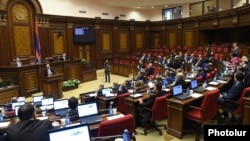The Armenian government has moved to abolish a legal limit on the size of the country’s public debt which has tripled in the past decade.
An Armenian law stipulates that the total amount of the government’s outstanding debts cannot exceed a sum equivalent to 60 percent of Gross Domestic Product. The debt-to-GDP ratio currently stands at 55.4 percent.
The National Assembly began debating on Tuesday a government bill that would scrap that debt ceiling which Finance Minister Vartan Aramian described as too restrictive and outdated.
As well as removing the borrowing cap, the bill would require the government to come up with a plan of actions to ease the debt burden. The government would also have to certify that fresh loans secured by it foster economic growth.
Answering questions from opposition lawmakers concerned about the initiative, Aramian claimed that it is not primarily aimed at allowing the government to obtain more multimillion-dollar loans.“The whole purpose of this package is not to enable us to borrow new loans but to set rules regarding what we should do, what fiscal-budgetary policies we should pursue,” he said.
“It’s not about getting or not getting loans,” he insisted moments later. “It’s about the nature of our fiscal-budgetary policy.”
The minister declined to specify whether the government plans to resort to further borrowing. But he did reaffirm its recent pledge to cut the debt-to-GDP ratio by one percentage point in 2018.
According to official statistics, economic growth in the country accelerated this year. The government expects it to remain relatively robust in 2018.
Armenia’s public debt, which also includes foreign loans extended to its Central Bank, passed the $6 billion mark recently. It stood at less than $2 billion before the 2008-2009 global financial crisis plunged Armenia into a severe recession. The authorities in Yerevan have since borrowed heavily from the World Bank, the International Monetary Fund and other external sources to prevent massive spending cuts and finance infrastructure projects.
Opposition politicians and other critics of the government increasingly voice concern at the rising debt. They also accuse the authorities of misusing external loans.
Government officials dismiss these claims. Aramian argued earlier that low-interest loans provided by the IMF, the World Bank and other international lenders account for the bulk of the national debt.
The minister acknowledged in February that budgetary expenditures on debt servicing will continue to rise and will peak at $500 million in 2020. The Armenian state budget for 2017 is worth roughly $3 billion.





Facebook Forum